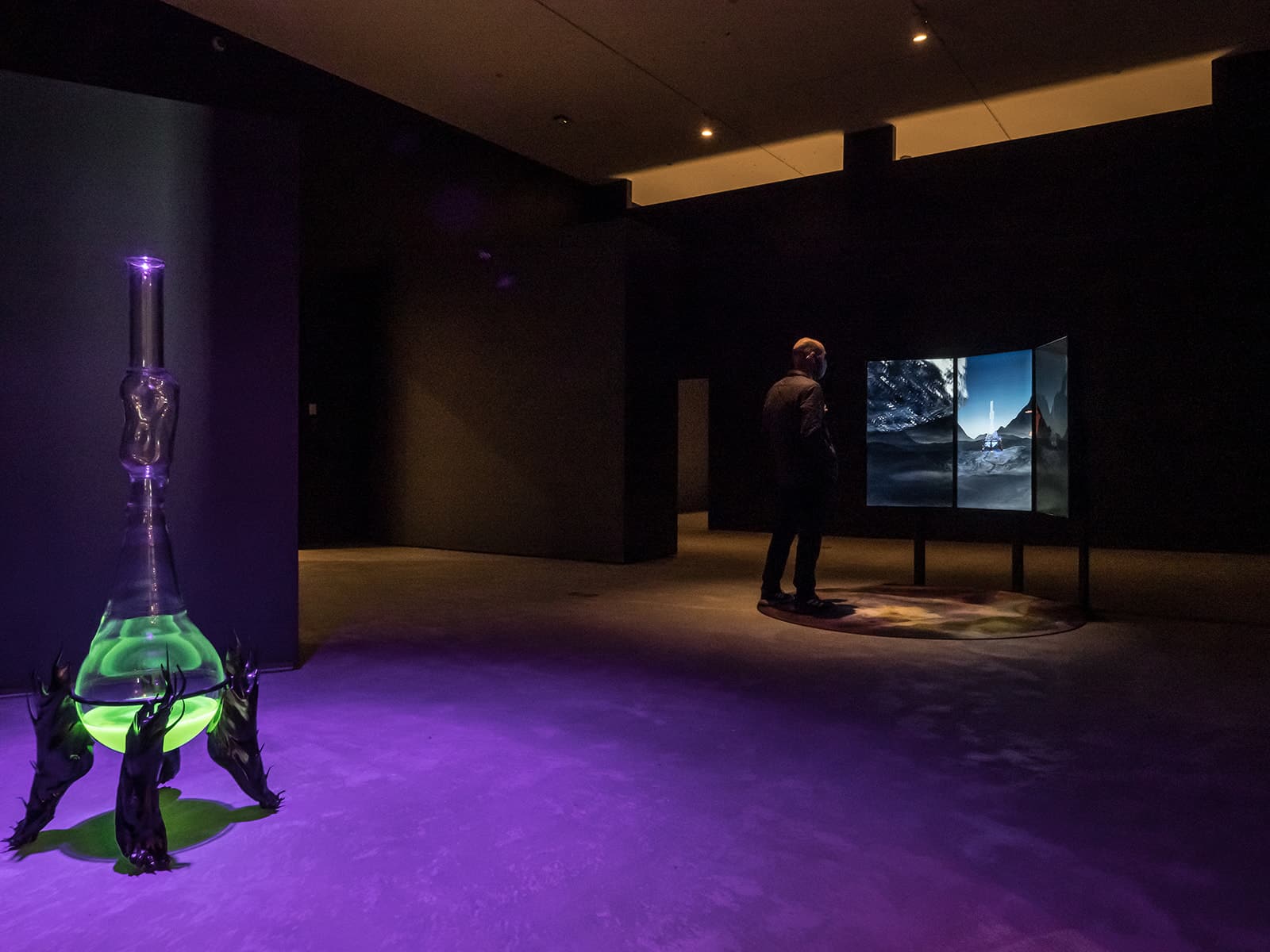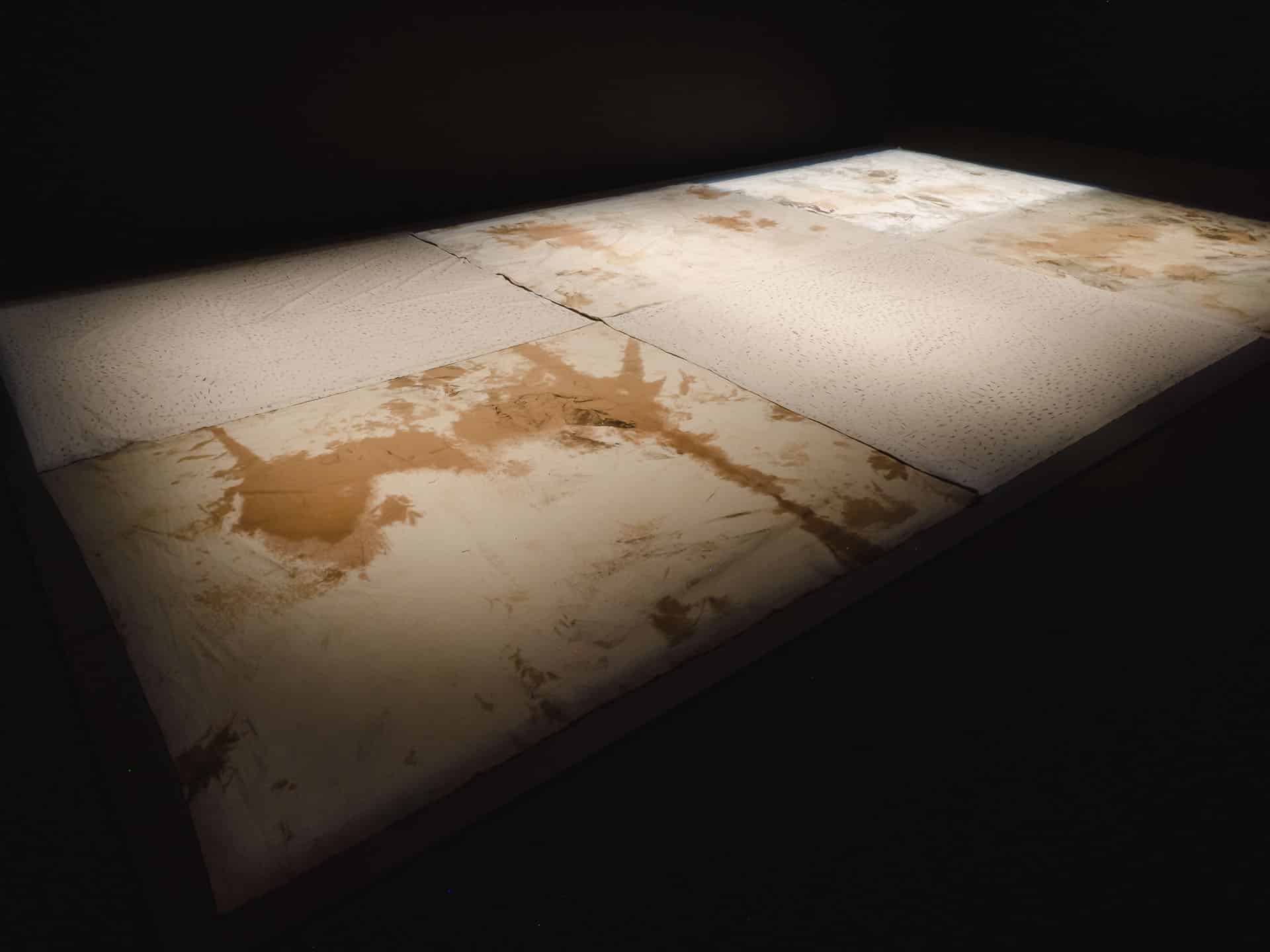Some kind of invisible matter is having a gravitational effect on everything. Without the gravity of this “dark” matter, galaxies would fly apart. Observational data in astroparticle physics indicate that it exists, but so far dark matter hasn’t been directly detected. Given the contours of such an unknown, artists Nadia Lichtig, Josèfa Ntjam, Anne Riley and Jol Thoms reflect on the “how” and “why” of physics and art as diverse and interrelating practices of knowledge. Through open exchange between disciplines, they have created works that are sensory agents between scientific ideas of dark matter and the exploration of that which has never been directly sensed.
Drift: Art and Dark Matter is a residency and exhibition project generated by Agnes Etherington Art Centre, the Arthur B. McDonald Canadian Astroparticle Physics Research Institute and SNOLAB. Four artists of national and international stature were invited to make new work while engaging with physicists, chemists and engineers contributing to the search for dark matter at SNOLAB’s facility in Sudbury, two kilometres below the surface of the Earth.
The title Drift draws from the mining term for a horizontal tunnel, in this case the hot underground passageway in the copper and nickel mine stretching between the elevator and the clean lab spaces of SNOLAB. The project thereby begins from a reflection on the forms and energies that connect physics to art, labour, landscapes, cultures and histories.
We acknowledge the support of the Canada Council for the Arts, Ontario Arts Council, an agency of the Government of Ontario, City of Kingston Arts Fund through the Kingston Arts Council and the George Taylor Richardson Memorial Fund at Queen’s University.
Morris and Helen Belkin Art Gallery, University of British Columbia
6 September–5 December 2021
Carleton University Art Gallery
1 February–3 April 2022
Art Museum at the University of Toronto
May–October 2022
The Arthur B. McDonald Canadian Astroparticle Physics Research Institute is the Canadian hub for astroparticle physics research, uniting researchers, theorists, and technical experts within one organization. Located at and led by Queen’s University, the McDonald Institute is proud to have thirteen partner universities and research institutes across the country, all of which are key players in Canada’s past and future innovation in astroparticle physics. VISIT site >
SNOLAB is a world-class science facility located deep underground in the operational Vale Creighton nickel mine, near Sudbury, Ontario in Canada. The combination of great depth and cleanliness that SNOLAB affords allows extremely rare interactions and weak processes to be studied. The science programme at SNOLAB is currently focussed on sub-atomic physics, largely neutrino and dark matter physics. SNOLAB seeks to enable, spearhead, catalyze and promote underground science, while inspiring both the public and future professionals in the field. VISIT website >

Installation view of Drift: Art and Dark Matter. Photo: Tim Forbes.

Josèfa Ntjam, Luciferin Drop, 2020, glass, metal, plastic and Myceaqua Vitae, 2020, video with sound. Collection of the artist. Installation view from Drift: Art and Dark Matter. Photo: Tim Forbes
Nadia Lichtig is an artist currently living in the South of France. In her multilayered work, voice is transposed into various media including painting, print, sculpture, photography, performance, soundscape and song—each medium approached not as a field to be mastered, but as a source of possibilities to question our ability to decipher the present. Visual and aural aspects entangle in her performances.
Lichtig studied linguistics at the LMU Munich in Germany and at the Ecole des Beaux-Arts de Paris, France with Jean-Luc Vilmouth, where she graduated with honours in 2001, before assisting Mike Kelley in Los Angeles, USA the same year. She taught at the Shrishti School of Art and Technology, Bangalore, India as a visiting professor in 2006, at the Ecole des Beaux-Arts of Valence in 2007, and is professor of Fine Arts at the Ecole Supérieure des Beaux-arts of Montpellier (MOCO-ESBA), France since 2009. She has collaborated with musicians who are also visual artists, such as Bertrand Georges (Audible), Christian Bouyjou (Popopfalse), Nicolu (La Chatte), Nina Canal (Ut) and Michael Moorley (The dead C). Nadia Lichtig worked and works under several group names and pseudonyms (until 2009: EchoparK, Falseparklocation, Skrietch, Ghosttrap and Nanana).
Josèfa Ntjam was born in 1992 in Metz (FR), and currently lives and works in Paris. Ntjam is part of a generation of artists who grew up with the internet, communicating and sending images by electromagnetic wave. Working with video, text, installation, performance and photomontage, Ntjam creates a story with every piece that acts as a reflection of the world around her. Drawing connections to science fiction and the cosmos, Ntjam has said of her work, “I sat there some time ago with Sun Ra in his Spaceship experimenting with a series of alternative stories. An exoteric syncretism with which I travel as a vessel in perpetual motion.”
Ntjam studied in Amiens and Dakar (Cheikh Anta Diop University) and graduated from l’Ecole Nationale Supérieure d’Art, Bourges (FR) and Ecole Nationale Supérieure d’Art, Paris-Cergy (FR). Her works and performance have been shown at numerous venues such as the 15th Biennial of Lyon, DOC! Paris, a la Zentral (CH), Palais de Tokyo, Beton Salon, La Cite internationale des arts, la Bienanale de Dakar (SN), Let Us Rflect Festival (FR), FRAC de Caen, and CAC Bretigny.
Anne Riley is a multidisciplinary artist living as an uninvited Slavey Dene/German guest from Fort Nelson First Nation on the unceded Territories of the Musqueam, Squamish and Tsleil-waututh Nations. Her work explores different ways of being and becoming, touch, and Indigeneity. Riley received her BFA from the University of Texas at Austin in 2012. She has exhibited both in the United States and Canada. Currently she is working on a public art project commissioned by the City of Vancouver with her collaborator, T’uy’tanat Cease Wyss. Wyss and Riley’s project A Constellation of Remediation consists of Indigenous remediation gardens planted throughout the city, decolonizing and healing the dirt back to soil. The duo was longlisted for the 2021 Sobey Art Award.
Riley’s that brings the other nearly as close as oneself, included in the 2015 exhibition Every Little Bit Hurts at Western Front, foregrounded touch, impression and embodied experience. It featured a wall drawing created by the artist rubbing, dragging and moving her body across the gallery wall wearing raw-dyed denim. “I’m interested in queer touch as a radical act,” she says. “It’s not always possible because of fear. But I’m also investigating first touch between mother and child. I have the same hands as my mother and my great grandmother.”
Jol Thoms is a Canadian-born, European-based artist, author and sound designer. Both his written and moving-image work engage posthumanism, feminist science studies, general ecology and the environmental implications of pervasive technical/sensing devices. In the fields of neutrino and dark matter physics he collaborates with renowned physics institutes around the world. These “laboratory-landscapes” are the focus of his practice led PhD at the University of Westminster. In 2017 Thoms was a fellow of Schloss Solitude and resident artist at the Bosch Campus for Research and Advanced Engineering.
Thoms graduated with an Honors BA in Philosophy, Art History and Visual Studies from the University of Toronto (2009) and later studied under Prof. Simon Starling at the Städelschule in Frankfurt (2013). Between 2014 and 2016 he developed and taught an experimental creative-research program for architecture students at the University of Braunschweig with then interim director Tomás Saraceno. In 2016 Thoms won the MERU Art*Science Award for his film G24|0vßß, which was installed in the Blind Faith: Between the Cognitive and the Visceral in Contemporary Art group exhibition at Haus der Kunst, Munich.

Nadia Lichtig, Blank Spots, 2021–ongoing, frottage on canvas, theatre lights, sound. Collection of the artist. Installation view from Drift: Art and Dark Matter. Photo: Tim Forbes

Anne Riley, the heart of the matter (still), 2020, video with sound. Collection of the artist.

Explore an online extension of Drift: Art and Dark Matter. See how artists have responded to transdisciplinary exchange.